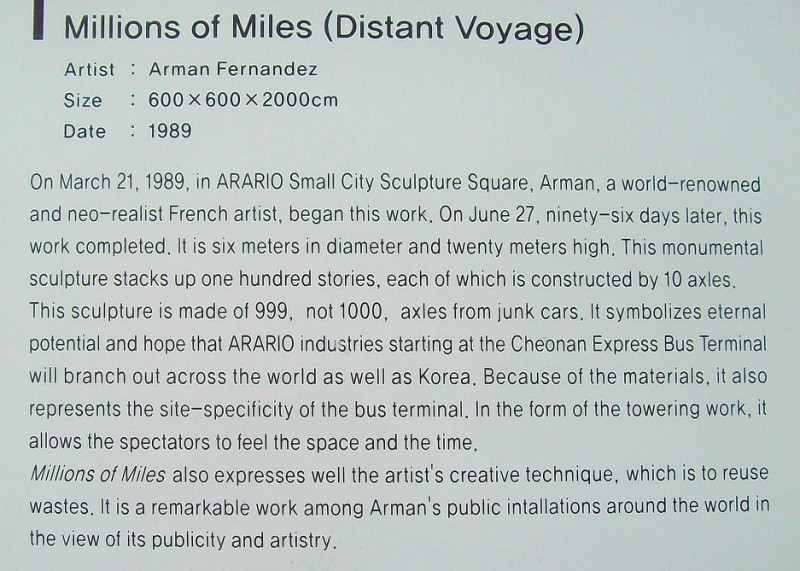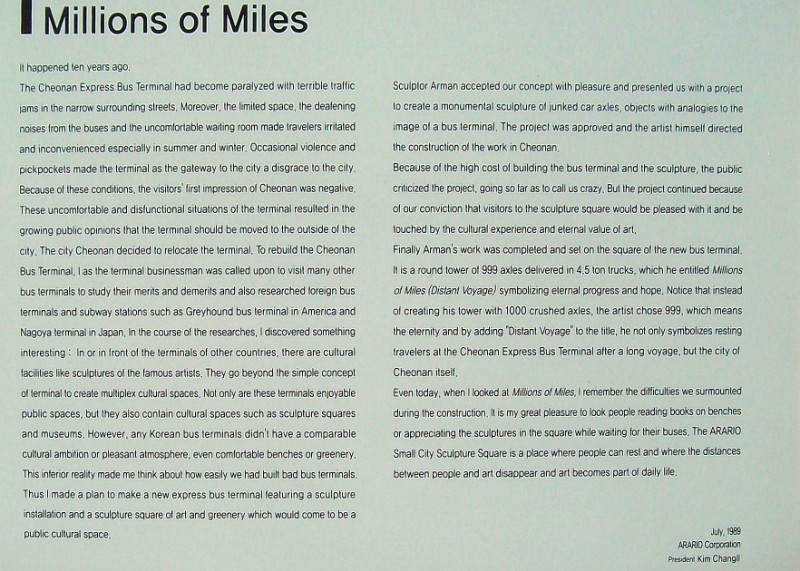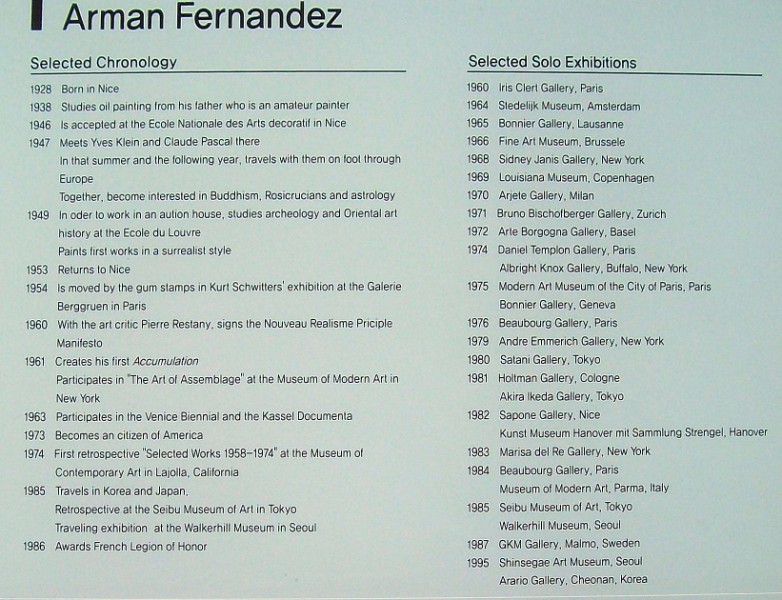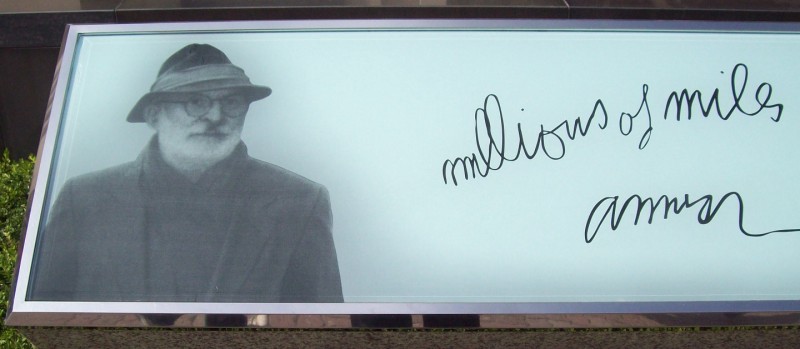
"Miillions of Miles" by Arman Fernandez - Cheonan, Korea
Posted by:  silverquill
silverquill
N 36° 49.135 E 127° 09.336
52S E 335496 N 4076371
Miillions of Miles" by renowned artist Arman Fernandez, consists of 999 axles stacked 100 layers to a height of 60 ft. (20m). Completed in 1989, it is located at the Express Bus Terminal in the city of Cheonan, Korea, as a towering symbol of hope.
Waymark Code: WM5F17
Location: South Korea
Date Posted: 12/30/2008
Views: 18

Millions of Miles (Distant Voyage)
Artist: Arman Fernandez
Size: 600 X 600 x 2000cm
Date: 1989
On March 21, 1989, in ARARIO Small City Sculpture Square, Arman, a world-renowned and neo-realist French artist, began this work. On June 27, ninety-six days later, this work completed. It is six meters in diameter and twenty meters high. This monumental sculpture is made of 999, not 1000, axles from junk cars. It symbolizes eternal potential and hope that ARARIO industries starting at the Cheonan Express Bus Terminal will branch out across the world as well as Korea. Because of the materials, it also represents the site -- spcificity of the bus terminal. In the form of the towering work, it allows the spectators to feel the space and time.
Millions of Milesalso expresses well the artist's creative technique, which is to reuse wastes. It is a remarkable work among Arman's public installations around the world in view of its publicity and artistry.

Millions of Miles
It happened ten years ago.
The Cheonan Express Bus Terminal had become paralyzed with terrible traffic jams in the narrow surrounding streets. Moreover, the limited space, the deafening noises from the buses adn the uncomfortable waiting room made travelers irritated and inconvenienced especially in summer and winter. Occasional violence and pickpockets made the terminal as the gateway to the city a disgrace to the city. Because of these conditions, the visitors' first impression of Cheonan was negative. These uncomfortable and disfunctional situations of the terminal resulted in the growing public opinions that the terminal should be moved to the outside of the city. The city of Cheonan decided to relocate the terminal. To rebuild the Cheonan Bus Terminal, I as the terminal businessman was called upon to visit many other bus terminals to study their merits and demerits and also researched foreign bus terminals and subway stations such as Greyhound bus terminal in America and Nagoya terminal in Japan. In the course of the researches, I discovered something interesting: In or in front of the terminals of other countries, there are cultural facilities like sculptures of the famous artists. They go beyond the simple concept of terminal to create multiplex cultural spaces. Not only are these terminals enjoyable public spaces, but they also contain cultural spaces such as sculpture squares and museums. However, any Korean bus terminals didn't have a comparable cultural ambition or pleasant atmosphere, even comfortable benches or greenery. This inferior reality made me think about how easily we had built bad bus terminals. Thus I made a plan to make a new express bus terminal featuring sculpture installation and a sculpture square of art and greenery which would come to be a public cultural space.
Sculptor Arman accepted our concept with pleasure and presented us with a project to create a monumental sculpture of junked car axles, objects with analogies to the image of the bus terminal. The project was approved and the artist himself directed the construction of the work in Cheonan.
Because of the high cost of building the bus terminal and the sculpture, the public criticized the project going so far as to call us crazy. But the project continued because of our conviction that visitors to the sculpture square would be pleased with it and be touched by the cultural experience and eternal value of art.
Finally Arman's work was completed and set on the square of the new bus terminal. It is a round tower of 999 axles delivered in 4.5 ton trucks, which he entitled Millions of Miles (Distant Voyage) symbolysing eternal progress and hope. Notice that instead of creating his tower with 1000 crushed axles, the artist chose 999, which means the eternity and by adding "Distant Voyage" to the title, he not only symbolizes resting travelers at the Cheonan Express Bus Terminal after a long voyage, but the city of Cheonan itself.
Even tody, when I looked at Millions of Miles, I remember the difficulties we surmounted during the construction. It is my great pleasure to look people reading books on benches or appreciating the sculptures in the square while waiting for their buses. The ARARIO Small City Sculpture Square is a place where people can rest and where the distances between people and art disappear and art becomes part of daily life.
July 1989
ARARIO Corporation
President Kim Changil



From the Wikipedia entry:
Arman (November 17, 1928 – October 22, 2005), was a French-born American artist. Born Armand Pierre Fernandez in Nice, France, Arman is a painter who moved from using the objects as paintbrushes ("allures d'objet") to using them as the painting itself. He is best known for his "accumulations" and destruction/recomposition of objects.
Of Arman's accumulations, one of the largest is Long Term Parking, which is on permanent display at the Chateau de Montcel in Jouy-en-Josas, France. Completed in 1982, the sculpture is an eighteen-meter high accumulation of sixty automobiles embedded in over forty thousand pounds of concrete. Just as ambitious was the 1995 work Hope for Peace, which was specially commissioned by the Lebanese government to commemorate fifty years of the Lebanese military’s service. Standing in once war-torn Beirut, the thirty-two meter monument consists of eighty-three tanks and military vehicles.
Arman Fernandwz